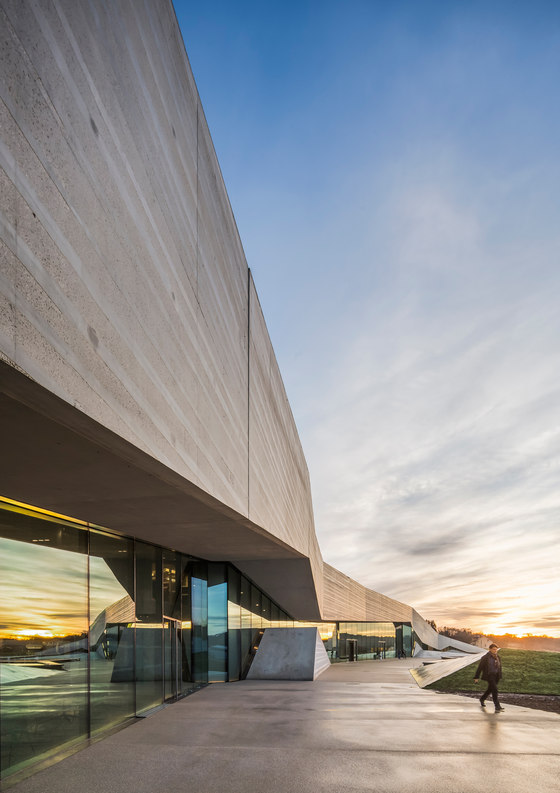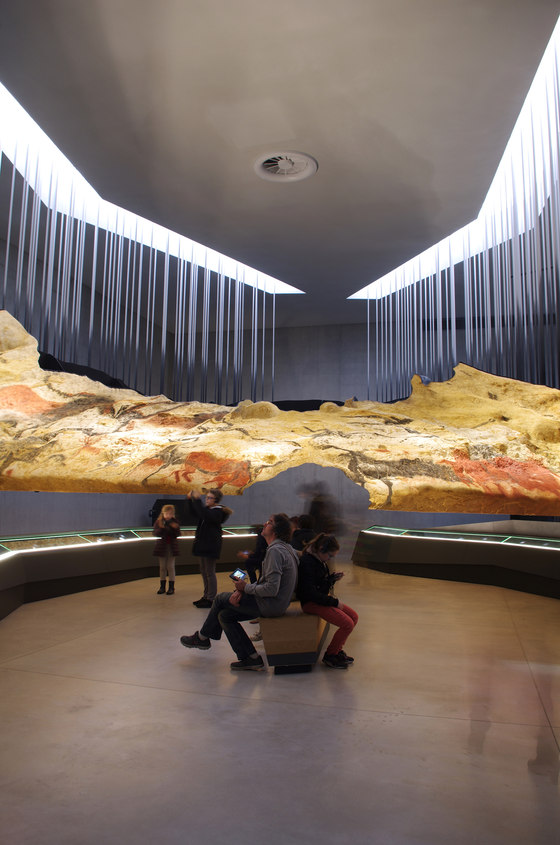The new International Centre for Cave Art (Centre International d’Art Parietal) in Montignac, France welcomes visitors to an immersive educational experience of the prehistoric Lascaux cave paintings. Known by archaeologists as the ‘Sistine Chapel of Prehistory’ due to their spiritual and historical significance, the 20,000-year-old paintings are among the finest known examples of art from the Paleolithic period.
Architects Snøhetta and SRA, alongside scenographer Casson Mann, worked closely with a team of archaeologists to create a holistic museum and educational experience. As an interpretation center featuring state-of-the-art experiential storytelling technology paired with a facsimile of the caves, Lascaux IV offers visitors an opportunity to discover the caves in a unique way that reveals a sense of wonder and mystery, as if they, too, were the first group of adventurers to stumble upon the cave paintings.
The Lascaux Caves paintings were first discovered in 1940, and opened to visitors in 1948. Soon after the opening, however, the mass influx of visitors and the exposure to exterior elements had begun to degrade the paintings. In 1963, the original Lascaux Caves were permanently closed to the public to preserve the extraordinary art from irreparable damage brought on by its overwhelming popularity, and the fragile site was granted UNESCO World Heritage Status in 1979. In 2010, for the 70th anniversary of the cave discovery, the International Centre for Cave Art project, Lascaux IV was announced.
As a striking, contemporary addition to the landscape of the Vézère Valley, Lascaux IV frames a new experience of some of the finest known examples of prehistoric art, and offers profound new ways of understanding the rich heritage of the site. The contemporary geometry and materiality also counters the potential trap of artifice: allowing the visitor to understand that they are in the presence of a reproduction, without distracting from the power of its impact. The exterior reflects the contours of the limestone geology and reveals a dramatic exhibition experience designed to transport the visitor into a cave complex complete with tunnels, chambers lit by shafts of broken sunlight, and paintings that are mediated by state of the art technology and scenographic techniques.
Wonder and mystery
The new Lascaux IV Caves Museum is situated at the intersection of two unique landscapes, between a densely-forested, protected hillside and the agricultural Vézère valley. Snøhetta’s design conceives the museum as a fine cut in the landscape, inviting visitors into a curious world of prehistory. It was here, deep in the caves below, that prehistoric artists produced extraordinary cave paintings over 20,000 years ago.
As a museum and interpretation centre, the project has opened up the possibility of visiting Lascaux, the most spectacular of all painted caves, to a new generation of visitors. The highlight is the facsimile cave that allows visitors to experience this mysterious environment, to touch the contours and textures of the stone and contemplate the ancient artworks.
Lascaux IV marks the beginning of a new phase in the celebration of the knowledge of this unique site and its cultural heritage. Through a holistic approach that considers the landscape, the architecture, the interior, and the scenography as a whole, the design aims to create an experience that educates visitors on the significance of the site while revealing the original wonder and mystery of its discovery.
Shaped by Light
The design of the building has been shaped by two principal sources of natural light. One is created by a lateral cut in the landscape that lifts and separate the two planes, pulling them apart to generate a vertical facade where the light enters the building horizontally. The other is a deep cut along the spine of the building, which reveals the horizontal glass surface of a skylight and allows light in vertically. Throughout the course of a day, visitors experience the various shades and intensities of light that are filtered through the roof glass and the façade.
As visitors make their way through the building, these changing light conditions subtly highlight the various functions and atmospheres of each space. From the darkness in the caves replicas, to the open sky in the garden, to the shadow-play in the orientation zone, visitors progress through a sequence of lighting conditions that is carefully attuned to how the eye responds to lightness and darkness.
At night, the exterior landscape is framed by the warm glow of the artificial lighting within, forming a discrete volume of light that describes the shape of the entrance façade and the shape of the spine.
A journey of discovery
The visitor experience is carefully sequenced. Beginning in the lobby, visitors ascend by a lift to the belvedere out on the roof, where they can enjoy a magnificent panoramic view of Montignac and the Vézère Valley. They then descend a gentle slope towards the cave facsimile, which follows the incline of the roof towards the edge of the forest until reaching the entrance to the replica. The winding path through the landscape and gradual descent back down to grade facilitates a mental transition through time and space, creating an experience similar to that of the cave’s first discoverers in 1940.
La grotte
Inside the replica, the atmosphere is damp and dark, re-creating the humidity within the caves. Sounds are muffled; the temperature drops to about 16 degrees Celsius. This sequence is dedicated to contemplation, allowing people an experience of the sanctuary that once was. Lights flicker just as the animal fat lamps of Paleolithic times did, revealing the rich layers of paintings and engravings on the surface of the walls.
The cave replica was developed through the most advanced 3D laser scanning and casting technologies to replicate the original cave form to a 1 millimeter tolerance. Following the construction, the caves underwent a careful analog process: 25 artists spent 2 years hand-painting 900 meters of resin rock reproductions. To ensure the highest level of accuracy, artists used the same pigments that the prehistoric painters used 20,000 years ago to recreate the 1900 paintings and engravings that adorn the walls of Lascaux IV.
Jardin de la grotte
Upon exiting the facsimile, the visitor arrives at a transition space known as the Jardin de la grotte, or the Cave Garden. This patio provides an opportunity to readjust to the exterior context, after the intense visceral and emotional experience of the replica. The relationship to the sky, the presence of plants and the sound of flowing water frame this moment.
The next sequence of chambers is devoted to deciphering the cave’s works to facilitate their comprehension and encourages visitors to gauge for themselves the historical, cultural, and symbolic stakes of the paintings. It is a pedagogic exhibition space enhanced by digital learning experiences, featuring interactive tables that enable people to deepen their individual discovery of Lascaux.
L’atelier de Lascaux
The dramatic journey leads to a series of diverse exhibition chambers. Visitors are equipped with an interactive digital companion device (CdV), an intelligent multimedia guide with audio and personalised language settings that enable visitors to interact with exhibits, providing augmented experiences, deeper information and content. This device liberates the gallery spaces from text panels – an important aspect of this experience, which blends art, history, culture, and contemplation. Casson Mann’s design for the scenography is grouped into thematic zones that immerse the visitor in thoughtfully crafted environments.
This first gallery is dedicated to a leisurely exploration of the main paintings seen in the facsimile. Eight great fragments of cave are dramatically suspended from the high ceiling or rise up from the stone floor.
On display within L’Atelier de Lascaux are:
Les Deux Bisons Adossés – Two Crossed Bisons
La Grande Vache Noire – The Great Black Cow
Le Panneau de l’Empreinte – The Chamber of Engravings
L’Abside – The Apse
La Scène du Puits – The Shaft Scene
Le Diverticule Axial – The Painted Gallery
Le Cheval Renversé – Upside Down Horse
La Salle des Taureaux – The Hall of Bulls
Visitors can examine each painting more closely. Here the panels are accompanied by explanations of how the paintings survived for so long, why the real cave is now closed, and how the artists of 20,000 years ago worked. These elements use projections to animate the work and give it life, allowing visitors to see the works up close and understand them in a way that is not possible within the cave replica itself. The visitor can move freely inside this space and use their digital companion to message their group or access more details in the form of images, animations and movies, allowing the visitor to explore a topic of interest in
depth.
In addition, a model map and interactive activities allow visitors to try various drawing, etching and painting techniques, and can handle replicas of objects found during archaeological excavations of Lascaux.
Le théâtre de l’art pariétal
This theatrical zone presents a three-act play using light, sound, movies and objects to give life to the story of Lascaux cave art. Each act takes place in a different space and visitors move from one to the other, discovering: the ‘history of prehistory’; the significance of cave art; what today’s scientists and archaeologists have found in caves.
La galerie de l’imaginaire
In the Imagination Gallery, visitors are able to explore the influence of prehistoric cave art on modern and contemporary artists in an interactive digital gallery. During their investigations visitors are invited to curate their own exhibition of images from the virtual library and then ‘post them’ up into the digital cave of contemporary art for all to see on a common public wall.
This content has been curated by John Paul Jouary, professor, philosopher and author, it is devoted to the relationship between Paleolithic art and the art of our time. Jouary’s work precisely defines the relationships between the different images, and he has meticulously prepared various thematic guides that visitors can follow on their CdV.
Zone d’orientation
Running through full length of the building, the central orientation zone is illuminated by a fissure of overhead light and evokes an almost sacred and spiritual character. With plenty of daylight and its generous size, the space becomes both an important tool for the flow between the various exhibition spaces, a place to rest between exhibitions as well as a social meeting point where visitors can gather.
Atmospheres and Intensities
The project balances stark differences in atmospheres and intensities of experience throughout, from the enclosed exhibition spaces ensconced in the hill, to the lightfilled lobby and transition spaces. In the same way, the juxtaposition between descent and ascent, inside and outside, earth and sky, or nature and art, evoke the analogous experience of the caves. These tensions speak to the enduring impact of the caves and their influence on contemporary culture. The program of the building is organized with a focus on simplicity and clarity. With a variety of offerings, each zone of the museum is customized to the content
communicated in each space.
Weaving together physical and interpretive concepts and spaces, the holistically conceived center unites Paleolithic art with contemporary approaches to spatial and experiential storytelling.
Conseil Général de la Dordogne
Snøhetta
Scenography: Casson Mann
Associate architect: SRA Architectes
Associate architect, study phase: Duncan Lewis Scape Architecture
Virtual reality specialist, study phase: Jangled Nerves
Construction economist: VPEAS
Structural design: Khephren Ingéniere
Fluids, roads and utilities engineering: Alto Ingénierie
Facades and glass design: RFR
Lighting designer: 8’18’’
Acoustical engineering: Commins dBlab
Management and operating company: Semitour Périgord





































